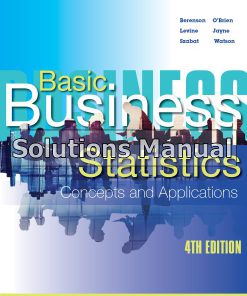Basics of Social Research Canadian 4th Edition Neuman Solutions Manual
$26.50$50.00 (-47%)
Basics of Social Research Canadian 4th Edition Neuman Solutions Manual.
You may also like
This is completed downloadable of Basics of Social Research Canadian 4th Edition Neuman Solutions Manual

Product Details:
- ISBN-10 : 0134308050
- ISBN-13 : 978-0134308050
- Author: W. Lawrence Neuman, Karen Robson
Basics of Social Research helps students understand what researchers do and why, while preparing them to think critically about how content findings are created.
The information in this text is presented in an easy to understand manner that allows students to see the importance of properly conducted research.
Updated Canadian content focuses on real research examples from Canadian studies to make social research accessible to students, and to demonstrate how social research has real-world applications.
Table of Content:
- Part I Foundations
- Chapter 1 Doing Social Research
- Learning Objectives
- Introduction
- Why Do Social Research?
- Alternatives to Social Research
- Authority
- Tradition
- Common Sense
- Media Myths
- Personal Experience
- How Science Works
- Science
- The Scientific Community
- The Scientific Method and Attitude
- Steps in the Research Process
- Use of Research
- Academic Research
- Applied Research
- Purpose of a Study
- Exploration
- Description
- Explanation
- Time Dimension in Research
- Cross-Sectional Research
- Longitudinal Research
- Time-Series Study
- Panel Study
- Cohort Study
- Case Studies
- Quantitative and Qualitative Approaches
- Quantitative Data Collection Techniques
- Experiments
- Surveys
- Content Analysis
- Existing Statistics
- Qualitative Data Collection Techniques
- Qualitative Interviews
- Focus Groups
- Field Research
- Historical Research
- Content Analysis
- Chapter Summary
- Review Questions
- Exercises
- Chapter 2 Theory and Social Research
- Learning Objectives
- Introduction
- What is Theory?
- Levels of Theory
- Empirical Generalizations and Middle-Range Theory
- The Parts of Theory
- Assumptions
- Agency and Structure
- Ontology and Epistemology
- Two Major Paradigms
- Positivist Approach
- Interpretive Approach
- Major Theoretical Frameworks
- Direction of Theorizing
- Deductive Approach
- Inductive Approach
- Explaining Relationships in Social Research
- Causal Explanation
- Temporal order
- Association
- Eliminating Alternatives
- Chapter Summary
- Review Questions
- Exercises
- Chapter 3 Ethics in Social Research
- Learning Objectives
- Introduction
- Why Be Ethical?
- Scientific Misconduct
- Unethical but Legal
- Power Relations
- Ethical Issues Involving Research Participants
- Origins of Research Participant Protection
- Physical Harm, Psychological Abuse, and Legal Jeopardy
- Physical Harm
- Psychological Abuse, Stress, or Loss of Self-Esteem
- Legal Harm
- Other Harm to Participants
- Maximizing Benefit
- Deception and Consent
- Informed Consent
- Special Populations and New Inequalities
- Privacy, Anonymity, and Confidentiality
- Privacy
- Anonymity
- Confidentiality
- Privacy, Anonymity, and Confidentiality in Online Research
- Respect for Human Dignity
- Mandated Protections of Research Participants
- Ethics and the Scientific Community
- Ethics and The Sponsors of Research
- Whistle-Blowing
- Arriving at Particular Findings
- Limits on How to Conduct Studies
- Suppressing Findings
- Concealing the True Sponsor
- Politics of Research
- Chapter Summary
- Review Questions
- Exercises
- Chapter 4 Reviewing the Scholarly Literature and Planning a Study
- Learning Objectives
- Introduction
- Locating Relevant Sources
- How to Find Research Literature
- Books
- Periodicals
- Scholarly Journals
- Other Types of Periodicals
- Dissertations
- Government Documents
- Policy Reports
- Citation Styles
- How To Conduct a Systematic Literature Review
- Define and Refine a Topic
- Design a Search Strategy
- Locate Research Reports
- Taking Notes
- What to Record
- Organize Your Notes
- Writing the Review
- Synthesize
- Avoid Failing to Synthesize
- Avoid Over-quoting
- Do Not Plagiarize
- The Difference Between a Good Review and a Bad Review
- Chapter Summary
- Review Questions
- Exercises
- Chapter 5 Designing a Study
- Learning Objectives
- Introduction
- Qualitative and Quantitative Orientations Toward Research
- Linear and Nonlinear Paths
- Preplanned and Emergent Research Questions
- Qualitative Design Issues
- The Language of Cases and Contexts
- The Context Is Critical
- The Case and the Process
- Interpretation
- Quantitative Design Issues
- The Language of Variables and Hypotheses
- Variation and Variables
- Types of Variables
- Causal Theory and Hypotheses
- The Hypothesis and Causality
- Testing and Refining Hypotheses
- Types of Hypotheses
- Aspects of Explanation
- Clarity About Units and Levels of Analysis
- Ecological Fallacy
- Example
- Reductionism
- Example
- Spuriousness
- Example 1
- Example 2
- Tautology and Teleology
- From the Research Question to Hypotheses
- Chapter Summary
- Review Questions
- Exercises
- Chapter 6 Qualitative and Quantitative Measurement
- Learning Objectives
- Introduction
- Why Measure?
- Quantitative and Qualitative Measurement
- Parts of the Measurement Process
- Quantitative Conceptualization and Operationalization
- Qualitative Conceptualization and Operationalization
- Conceptualization
- Operationalization
- Reliability and Validity
- Reliability and Validity in Quantitative Research
- Reliability
- How to Improve Reliability
- Clear Conceptualization
- Increase the Level of Measurement
- Use Multiple Indicators of a Variable
- Use Pretests, Pilot Studies, and Replication
- Validity
- Types of Measurement Validity
- Face Validity
- Content Validity
- Criterion Validity
- Reliability and Validity in Qualitative Research
- Reliability
- Validity
- The Relationship between Reliability and Validity
- Other Uses of the Terms Reliability and Validity
- Reliability
- Internal Validity
- External Validity
- Statistical Validity
- A Guide to Quantitative Measurement
- Levels of Measurement
- Continuous and Discrete Variables
- Four Levels of Measurement
- Precision and Levels
- Distinguishing among the Four Levels
- Mutually Exclusive and Exhaustive Attributes
- Specialized Measures: Scales and Indices
- Indices and Scales
- Index Construction
- The Purpose
- Scales
- The Purpose
- Logic of Scaling
- Commonly Used Scales
- Likert Scale
- Rates and Standardization
- Chapter Summary
- Review Questions
- Exercises
- Chapter 7 Qualitative and Quantitative Sampling
- Learning Objectives
- Introduction
- Nonprobability Sampling
- Haphazard, Accidental, or Convenience Sampling
- Quota Sampling
- Purposive Sampling
- Snowball Sampling
- Sequential Sampling
- Probability Sampling
- Populations, Elements, and Sampling Frames
- Why Random?
- Types of Probability Samples
- Simple Random
- Systematic Sampling
- Stratified Sampling
- Cluster Sampling
- Probability Proportionate to Size (PPS)
- Random-Digit Dialing
- Hidden Populations
- How Large Should a Sample Be?
- Drawing Inferences
- Chapter Summary
- Review Questions
- Exercises
- Part II Conducting Quantitative Research
- Chapter 8 Survey Research
- Learning Objectives
- Introduction
- Research Questions Appropriate for a Survey
- The Logic of Survey Research
- What Is a Survey?
- Steps in Conducting a Survey
- Constructing the Questionnaire
- Principles of Good Question Writing
- Aiding Respondent Recall
- Questions Requiring Special Consideration
- Threatening Questions
- Socially Desirable Questions
- Knowledge Questions
- Skip or Contingency Questions
- Open versus Closed Questions
- Nonattitudes and the Middle Positions
- Agree/Disagree, Rankings or Ratings?
- Wording Issues
- Questionnaire Design Issues
- Length of Survey or Questionnaire
- Question Order or Sequence
- Organization of Questionnaire
- Order Effects
- Context Effects
- Format and Layout
- Questionnaire Layout
- Question Format
- Nonresponse
- Types of Surveys: Advantages and Disadvantages
- Mail and Self-Administered Questionnaires
- Advantages
- Disadvantages
- Online Surveys
- Advantages
- Disadvantages
- Telephone Interviews
- Advantages
- Disadvantages
- Face-to-Face Interviews
- Advantages
- Disadvantages
- Interviewing
- The Role of the Interviewer
- Stages of an Interview
- Training Interviewers
- Interviewer Bias
- Computer-Assisted Interviewing
- The Ethical Survey
- Chapter Summary
- Review Questions
- Exercises
- Chapter 9 Experimental Research
- Learning Objectives
- Introduction
- Research Questions Appropriate for an Experiment
- The Issue of an Appropriate Technique
- Research Questions for Experimental Research
- Random Assignment
- Why Randomly Assign?
- How to Randomly Assign
- Matching versus Random Assignment
- Experimental Design Logic
- The Language of Experiments
- Parts of the Experiment
- Steps in Conducting an Experiment
- Control in Experiments
- Types of Design
- Classical Experimental Design
- Example
- Pre-experimental Designs
- One-Shot Case Study Design
- Example
- One-Group Pretest–Post-test Design
- Example
- Static Group Comparison
- Example
- Quasi-Experimental and Special Designs
- Two-Group Post-test–Only Design
- Interrupted Time Series
- Equivalent Time Series
- Latin Square Designs
- Solomon Four-Group Design
- Factorial Designs
- Design Notation
- Internal and External Validity
- The Logic of Internal Validity
- Threats to Internal Validity
- Selection Bias
- History Effects
- Maturation
- Testing Effect
- Instrumentation
- Mortality
- Statistical Regression
- Diffusion of Treatment or Contamination
- Experimenter Expectancy
- External Validity and Field Experiments
- Reactivity
- Field Experiments
- Natural Experiments
- Practical Considerations
- Planning and Pilot Tests
- Instructions to Subjects
- Post-experiment Interview
- Results of Experimental Research: Making Comparisons
- A Word on Ethics
- Chapter Summary
- Review Questions
- Exercises
- Chapter 10 Nonreactive Quantitative Research and Secondary Analysis
- Learning Objectives
- Introduction
- Nonreactive Measurement
- The Logic of Nonreactive Research
- Varieties of Nonreactive or Unobtrusive Observation
- Recording and Documentation
- Quantitative Content Analysis
- What Is Content Analysis?
- Topics Appropriate for Quantitative Content Analysis
- Measurement and Coding
- General Issues
- Units
- What Is Measured?
- Coding, Validity, and Reliability
- Manifest Coding
- Latent Coding
- Intercoder Reliability
- How to Conduct Content Analysis Research
- Question Formulation
- Units of Analysis
- Sampling
- Variables and Constructing Coding Categories
- Inferences
- Existing Statistics and Documents and Secondary Data Analysis
- Appropriate Topics
- Social Indicators
- Locating Data
- Locating Existing Statistics
- Secondary Survey Data
- Limitations
- Units of Analysis and Variable Attributes
- Validity
- Reliability
- Missing Data
- Ethical Concerns
- Chapter Summary
- Review Questions
- Exercises
- Chapter 11 Analysis of Quantitative Data
- Learning Objectives
- Introduction
- Dealing with Data
- Coding Data
- Entering Data
- Cleaning Data
- Results with One Variable
- Frequency Distributions
- Measures of Central Tendency
- Measures of Variation
- Results with Two Variables
- A Bivariate Relationship
- Seeing the Relationship: The Scattergram
- What Is a Scattergram (or Scatterplot)?
- How to Construct a Scattergram
- What Can You Learn from the Scattergram?
- Form
- Direction
- Precision
- Bivariate Tables
- What Is a Bivariate Table?
- Reading a Percentaged Table
- Bivariate Tables without Percentages
- Measures of Association
- More than two Variables
- Statistical Control
- Constructing Trivariate Tables
- Linear Regression Analysis
- Inferential Statistics
- The Purpose of Inferential Statistics
- Statistical Significance
- Levels of Significance
- Type I and Type II Errors
- Chapter Summary
- Review Questions
- Exercises
- Part III Conducting Qualitative Research
- Chapter 12 Qualitative Interviewing
- Learning Objectives
- Introduction
- Research Questions Appropriate for Qualitative Interviewing
- Similarities and Differences between Qualitative Interviews and Friendly Conversations
- Key Elements in Qualitative Interviewing
- Interview Guide
- Asking Questions in Qualitative Interviews
- Kvale Question Types
- Sampling in Qualitative Interviews
- How Many People to Interview?
- Incentives
- Interview Sites
- Recording and Transcribing
- Advantages and Limitations of Qualitative Interviews
- From the Perspective of the Interviewee
- Data Rich with Description
- Development of New Theories
- Development of New Avenues of Research
- Problems with Validity and Reliability
- Focus Groups
- The Focus Group Procedure
- The Role of the Moderator
- Composition of Focus Groups
- The Number of Groups in a Focus Group Study
- Focus Groups as Social Groups
- Qualitative Data Resources
- Chapter Summary
- Review Questions
- Exercises
- Chapter 13 Field Research
- Learning Objectives
- Introduction
- Questions Appropriate for Field Research
- Ethnography
- The Logic of Field Research
- What Is Field Research?
- Steps in a Field Research Project
- Preparing, Reading, and Defocusing
- Selecting a Field Site and Gaining Access to It
- Entering the Field and Establishing Social Relations with Members
- Level of Involvement
- Strategy for Entering
- Planning
- Negotiating
- Disclosing
- Adopting a Social Role and Learning the Ropes
- Presentation of Self
- Researcher as Instrument
- An Attitude of Strangeness
- Building Rapport
- Charm and Trust
- Understanding
- Relations in the Field
- Roles in the Field
- Pre-existing versus Created Roles
- Limits on the Role Chosen
- Normalizing Social Research
- Maintaining Relations
- Social Relations
- Small Favours
- Conflicts in the Field
- Appearing Interested
- Observing and Collecting Data
- Watching and Listening
- Observing
- Listening
- Taking Notes
- Types of Field Notes
- Jotted Notes
- Direct Observation Notes
- Researcher Inference Notes
- Analytic Notes
- Personal Notes
- Maps and Diagrams
- Machine Recordings to Supplement Memory
- Data Quality
- Trustworthiness of Data
- Credibility
- Transferability
- Dependability
- Confirmability
- Focusing and Sampling
- Focusing
- Sampling
- Leaving the Field
- Ethical Dilemmas of Field Research
- Deception
- Confidentiality
- Involvement with Deviants
- Publishing Field Reports
- Chapter Summary
- Review Questions
- Exercises
- Chapter 14 Nonreactive Qualitative Research
- Learning Objectives
- Introduction
- Historical research
- Research Questions Appropriate for Historical Research
- The Logic of Historical Research and Quantitative Research
- Quantitative versus Historical Research
- The Logic of Historical Research and Interpretive Research
- A Distinct Historical Approach
- Similarities to Field Research
- Unique Features of Historical Research
- Steps in a Historical Research Project
- Conceptualizing the Object of Inquiry
- Locating Evidence
- Evaluating Quality of Evidence
- Organizing Evidence
- Synthesizing
- Writing a Report
- Data and Evidence in Historical Context
- Types of Historical Evidence
- Primary Sources
- Secondary Sources
- Running Records
- Recollections
- Research with Secondary Sources
- Uses and Limitations
- Potential Problems
- Research with Primary Sources
- Equivalence in Historical Research
- The Importance of Equivalence
- Contextual Equivalence
- Conceptual Equivalence
- The Qualitative Analysis of Text
- Research Problems Appropriate for Qualitative Content Analysis
- The Major Differences between Qualitative and Quantitative Content Analyses
- The Different Types of Qualitative Content Analyses
- Discourse Analysis
- Chapter Summary
- Review Questions
- Exercises
- Chapter 15 Analysis of Qualitative Data
- Learning Objectives
- Introduction
- Comparing Methods of Data Analysis
- Similarities
- Differences
- Explanations and Qualitative Data
- Coding and Concept Formation
- Conceptualization
- Coding Qualitative Data
- Analytical Memo Writing
- Did I Do It Right?
- Other Techniques
- Flowchart and Time Sequence
- Diagrams
- Chapter Summary
- Review Questions
- Exercises
- Part IV Mixing Quantitative and Qualitative Methods
- Chapter 16 Combining Methods in Social Science Research
- Learning Objectives
- Introduction
- Overall Advantages and Disadvantages of the Quantitative Approaches
- Advantages and Disadvantages of Specific Quantitative Approaches
- Survey Research
- Experiments
- Nonreactive Methods
- Overall Advantages and Disadvantages of Qualitative Approaches
- Advantages and Disadvantages of Specific Qualitative Approaches
- Qualitative Interviews
- Focus Groups
- Field Research
- Historical Research
- Qualitative Content Analysis
- Mixing Methods in Qualitative-only and Quantitative-only Analyses
- Mixing Quantitative Methods with Quantitative Methods
- Mixing Qualitative Methods with Qualitative Methods
- Mixing Quantitative and Qualitative Methods
- The Stages of Mixed Methods Research
- Priority and Sequence in Data Collection
- Sequential and Concurrent as Procedure in Data Analysis
- Sampling in Mixed Methods Designs
- The Role of Theory in Mixed Methods Research
- Theory in Sequential Mixed Methods Studies
- Theory in Concurrent Mixed Methods Studies
- Obtaining Conflicting Results
- Arguments Against Mixing Methods
- Chapter Summary
- Review Questions
- Exercises
- Appendix Doing a Research Project
- Introduction
- Step 1: Picking a Topic and Narrowing It to a Research Question
- Step 2: Theoretical Considerations
- Step 3: Reviewing the Literature
- Step 4: Designing Your Study and Selecting Your Data Collection Method
- Step 5: Selecting Your Sample
- Step 6: Preparing Your Instrument
- Step 7: Collecting Your Data
- Step 8: Analyzing Your Data
- Step 9: Writing Up Your Findings
- Glossary
- Endnotes
- References
- Name Index
- A
- B
- C
- D
- F
- G
- H
- I
- J
- K
- L
- M
- N
- O
- P
- R
- S
- T
- V
- W
- Y
- Z
- Subject Index
- A
- B
- C
- D
- E
- F
- G
- H
- I
- J
- K
- L
- M
- N
- O
- P
- Q
- R
- S
- T
- U
- V
- W
- Z
People Also Search:
basics of social research canadian neuman
basics of social research canadian 4th edition neuman
basics of social research canadian
basics of social research canadian 4th edition
basics of social research canadian 4th edition download scribd
basics of social research canadian 4th edition solution manual download pdf












